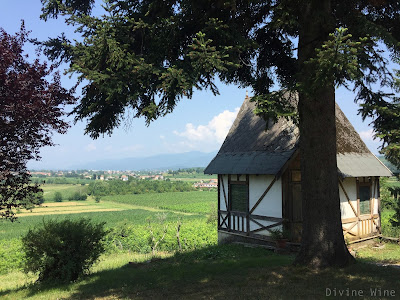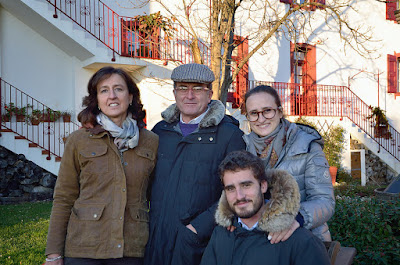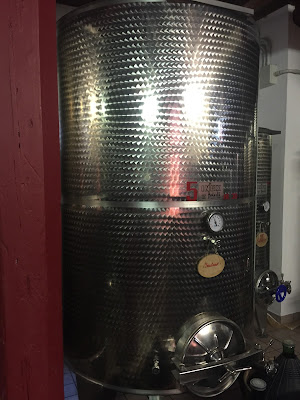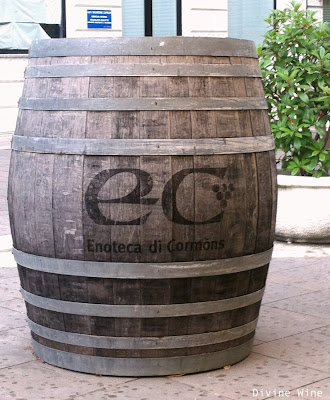 |
| Our sunny host Federico behind the bar in the frasca. |
White wine
tasting in the frasca
In Friuli,
there is no wine tasting without a frasca,
a Friulian wine bar. This concept combines wine tasting (and drinking) with enjoying
local air-dried ham and local cheese. Stroppolatini’s frasca
used to be the home for the farm’s pigs, hens and pigeons, but today it is a
venue for all kinds of celebrations.
To start our extensive, as well as humour filled, wine tasting process, Federico introduces us to the two different kinds of Friulano Stroppolatini makes: the classic Friulano aged in stainless steel, and Friulano Colle di Giano aged in French and Slavonian tonneaux. You can find the the background to these two styles, as well as the story of Stroppolatini winery in my recent blog post, visit to Stroppolatini part I. This time, dear vinous friends, we’ll just get straight to the experience of tasting these wines.
To start our extensive, as well as humour filled, wine tasting process, Federico introduces us to the two different kinds of Friulano Stroppolatini makes: the classic Friulano aged in stainless steel, and Friulano Colle di Giano aged in French and Slavonian tonneaux. You can find the the background to these two styles, as well as the story of Stroppolatini winery in my recent blog post, visit to Stroppolatini part I. This time, dear vinous friends, we’ll just get straight to the experience of tasting these wines.
 |
| The 170 years old Friulano vines grow in front of the small violinist's house. |
Friulano
2012
The classic
version simply named Friulano, matures in contact with fine lees for 18 to 20
months in stainless steel. During this time its structure becomes rounder, and
the wine develops more body and complexity.
While
tasting I’m immediately draw to the floral nature of this wine. Also, there are
citrus and almond aromas, and elegant minerality. Federico comments that the
vintage of 2012 was less sunny and hot towards the harvest, which might explain
the prominence of floral aromas, as they are sensitive to light. On the palate,
the wine is medium bodied, round and fruity, and shows complexity of aromas.
The medium acidity supports the wine’s structure, and the fruit, alcohol and
structural elements are in good balance. Ending with a varietally typical
medium plus length almond finish, this wine leaves a pleasant impression.
 |
| Friulano Colle di Giano 2012. Note the violinist's house label. |
Friulano
Colle di Giano 2012
Let’s now
proceed to Friulano Colle di Giano, il capo Giuliano’s experiment. This Friulano
version has been made from he same base wine as previous classic Friulano, but
has gone through malolactic fermentation and has been aged in neutral oak tonneaux
for 20 to 24 months (instead of stainless steel). These two processes have
softened the acidity of the wine, added to its body, and developed complex
layers of aromas.
Now the
floral realm is more of honeyed nature, the almonds and nuts are now more in
the foreground and on the palate the sensations approach full body. This version
of Friulano is creamy and silky with an elegant mineral edge. The finish is
long, creamy and almondy. What a pleasure. Please, il capo, keep on
experimenting!
 |
| Attenti al capo! |
The cellar
full of red treasures
Our cheery
wine tasting proceeds from the frasca
to the pleasantly cool and enchantingly antique wine cellar. Federico and his
sister, Marianna, have decorated the cellar with wine work inspiring quotes of
both philosophical and practical nature. The barrels are organized in two
storeys, hence it is good that Federico has written also a warning on the most
risky cross beam: ”Attenti al capo!”, which translates both ”Mind the head!”
and ”Mind the boss!”. The boss of the winery, il capo Giuliano, is not to be
forgotten while working in the cellar, laughs Federico, and we guests dear to
laugh along. In this family winery winemaking is meticulous and sincere as well
as humorous and heartfelt.
Merlot 2012
The first
red barrel Federico approaches is Merlot 2012, which, as all of Stroppolatini
wines, is a 100% single varietal wine. Tasting this Merlot brings me to think
of the two different climate impacts Friuli enjoys: on one hand the warm, sunny
Mediterranean climate, and on the other hand, the cooling effect of air flowing
between the nearby Alps and Adriatic sea. This airflow enhances the development
of complex aromas. This Merlot has concentration of fruit derived from ripe
grapes, while it has retained herbal, floral and red fruit flavours such as
raspberry and cherry. Even cherries in
rum reach my nose. The complex fruit aromas of this medium to full-bodied wine
are beautifully balanced by a proper backbone of medium tannins and equal
acidity. I confess. I’m already impressed by this very first red wine. Federico
shares that he finds this Merlot very versatile: it works well as an everyday
wine, but is sufficiently refined for moments of celebration. Absolutely, I
agree.
Excitement
is in the air as Federico steers towards the Refosco barrel. This is my first
encounter with this variety, and dear vinous readers, these kinds of moments
are always highly remarkable to me, a devoted autochthon grape mad. Federico
tells that in Friuli area Refosco is made in all kinds of versions from simple
to very noble. It is a kind of grape that is suspect to changes in wine fashion,
and in the recent years there was a period when Refosco was completely
abandoned by the local market. There was no use bottling it, since nobody
bought it! But, fortunately, now Refosco is back. And I can’t wait to taste it!
This wine
has it all. An elegant minerality, black pepper spice and herbal notes support
nuanced floral aromas. All this is backed up by wild, black forest fruit such
as blackberries and blueberries. The complexity of the aromas is intense, yet
elegant. Further, on the palate the wine is very structured. There are plenty
of tannins and acid to give it a sturdy back and balance the concentrated
fruit. However, the overall impression is lightened by the prominent floral and
mineral flavour elements. A long and pleasant aftertaste of flowers and forest
fruit keeps on lingering. At this instant I’ve become Refosco dal Penduncolo
Rosso’s friend for life.
 |
| Federico climbs to the heights to reach the Refosco barrel. |
Schioppettino
2012
The
autochthon grape celebration is only to get more intense as Federico introduces
us to Schioppettino. This variety is as local as it gets. In the whole of
Italy, Schioppettino has its only DOC in Friuli. Its name derives from the
relaxed, less technically aware way it was common to make it earlier, which
left residual sugar in the wine and every so often a secondary fermentation
took place in the bottle, causing it to sparkle on the tongue, and pop the
corks out of bottles (schioppettare in Italian = crackle in English).
Stroppolatini’s
Schioppettino is faithfully reflective of the characteristics of its variety:
it is spicy with red fruit character, mineral and high in tannin. However,
although this variety is typically known for its high acidity, in the case of
Stroppolatini the outcome is medium in acidity. Federico shares that
Schioppettino typically ages in a curious way. When it is young, it shows
primarily spicy or herbaceous character, and aggressive tannin. However, when
it becomes four years of age, it changes its aromatic and structural character
almost overnight. Suddenly it becomes fruit-driven and soft in tannin. Might
this be a polymerisation event that
takes place in a rapid cascade of some sort? While I’m pondering this
mystery, the last wine of this blog post is poured to my glass.
Cabernet
Franc 2012
Cabernet
Franc is well know as a part of right bank Bordeaux blends and the grape of the
reds from the Loire valley. It is a herbaceous grape variety that has a genetic
relationship e.g. to Carmenere, a very herbaceous variety cultivated nowadays
mainly in Chile. First, in Chile it was assumed that these vines were Merlot,
but the mistake was corrected as the very spicy, herbaceous wine produced was
evidently not Merlot. In Friuli, the mistake made was more logical: Carmenere
vines were first assumed to be Cabernet Franc vines. This was closer to the
truth as both varieties show herbaceous
character. Still, Carmenere has double the amount. In Chile the nomenclature
wsa corrected, but in Friuli people got used to calling their Carmenere wine
Cabernet Franc. For them ”Cabernet Franc” needs to taste just this spicy and herbaceous,
and they are sticking to their guns. Consequently, also at Stroppolatini the
wine is labelled Cab. Franc, although they inform very clearly that this spicy
and green bell pepper tasting wine is actually made of Carmenere grapes.
It comes as
no surprise, that a pronounced spicy, grassy and bell pepper aroma reaches my
nose already before I stick it to the glass. The aromas of black pepper spice,
grass and green as well as red bell pepper are equally evident on the palate.
The structure of this medium bodied wine is freshly acidic and medium in
tannin, and its alcohol is well integrated.
 |
| I try to make contact - however Tom the cat is busy stalking his prey. |
Tom the cat
keeps us company
Dear vinous
friends, we’ve reached a point in our journey, where we are soon to taste the
flagship wine of Stroppolatini winery: Pignolo. But I’m now painfully aware of
the already extended length of the blog post at hand. So, I decide that I will
still return to Stroppolatini a third time, and I will write a separate story on Pignolo
only. Besides, this wonderful, edgy, yet elegant Stroppolatini wine deserves its
own space and time in the spotlight.
We are
fortunate to be able to vertically taste three different Pignolo vintages, and
while we are at Pignolo 2010 on the terrace outside the frasca, we suddenly get company. The exact moment Marianna kindly
brings us very thinly sliced, deliciously fragrant prosciutto, bam!, Tom the cat suddenly appears next to me. ”He
arrives when the ham arrives”, says amused Federico. But why does Tom have
almost only one tooth left? Well, although Tom is offered plenty of proper cat
food, he finds eating normal food rather boring. He is a country cat that likes
to hunt and stalk everything that moves, and well, doesn’t move (the ham).
Federico suspects that Tom eats stones alongside with his preys, because he looses teeth all the time. At this pace
there is soon only one tooth left. No worries though, Tom, these thin
prosciutto slices melt in you mouth anyway, with or without teeth!
***
We will return to Stroppolatini for a vertical
Pignolo tasting in the near future, I promise. Next time, however, we will make
a stop in Milan, since I’ve got juicy vinous news from there in store for you,
dear readers!












